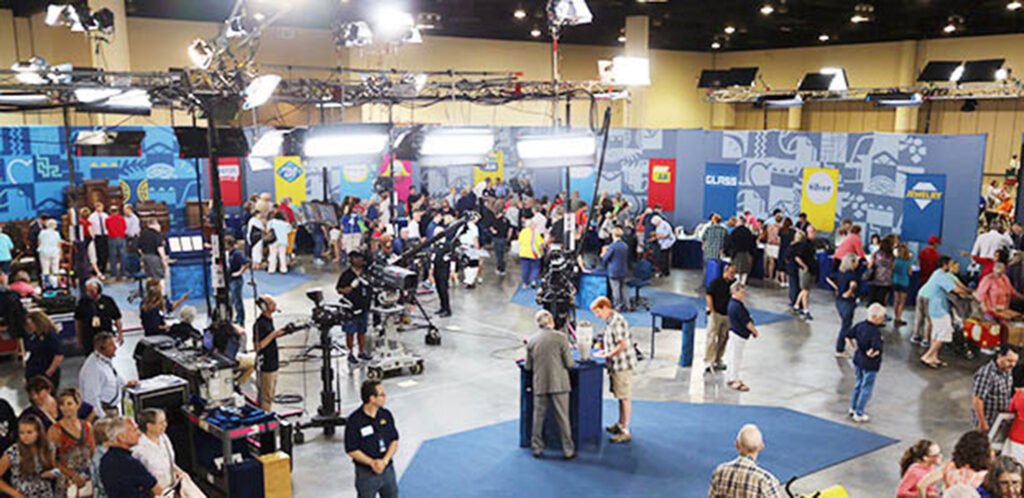
PBS’ “Antiques Roadshow” will specialize in space collectibles on next Monday’s program in keeping with the theme, “Out of This World.” (Handout/TNS)
PASADENA — Ever since “Antiques Roadshow” premiered on public television, grandma’s cracked teapot, that dusty painting in the attic and the wobbly chair in the basement take on a new shine. People realize they might be harboring a real fortune and not even know it.
It’s been 23 years since “Antiques Roadshow” hit the road, and the treasures just keep coming.
Over the years the show has traveled across the nation, working with 500 appraisers who donate their time to pore over the autographed baseball, the Tiffany lamp, the Civil War uniform.
Since the series began it has hosted 1.4 million appraisals, and July 8 it will conquer space with its “Out of this World” event. In keeping with PBS’ “Summer of Space,” which commemorates America’s journey into the outer limits, the “Roadshow” will scrutinize space-themed booty collated from shows across the years.
It will include items like autographed NASA space program photos, an aviation autograph collection with signatures of Amelia Earhart, John Glenn, Neil Armstrong, etc., a celestial atlas dating back to the 1700s, as well as artifacts from the world of science fiction like “Star Trek” memorabilia.
It’s not so much the value of the item that makes the show interesting, says executive producer Marsha Bemko. It’s the story and the history.
“I think the magic is that it’s smart reality television,” she says. “You’re not going to watch ‘Antiques Roadshow’ and not learn something about our world and our country. You can’t help it. You will learn about American history in particular because a majority of what we see are American objects. There’s a sizzle to it.”
One of the major components of that “sizzle” is appraiser Leila Dunbar, who’s appeared on the show since it premiered. Dunbar is an expert on sports memorabilia as well as entertainment, posters, comic books, animation, transportation memorabilia and art.
“The whole premise of the show is an exchange of information,” says Dunbar. “You come in and you tell us your story, and we try to fill in the blanks for you.”
But the show has changed over the years, says Dunbar. “When it started, I feel it was a very object-driven experience — both for us and for the guests who came in — because face it, ‘Roadshow’ is the History Channel meeting ‘Who Wants to Be a Millionaire,’ right?’ she says.
“ … I don’t think people realize with ‘Roadshow,’ you had thousands of people that come through in the beginning with the convention centers. You had 5,500 people, 12,000 to 15,000 objects, (and) 70 of us and three producers,” Dunbar recalls.
“It’s a large game of musical chairs. So we were just trying to get through the day and get through all the appraisals. And the guests would come in, and they’d be in line for hours. And by the time they got to us, they just wanted to know, ‘Am I going to get on TV?’
“Now I think we’re probably in another generation, we’ve become friends to these folks. And for five days a year, we’re Cinderellas and Cinderfellas. We’re rock stars. We’re normal people every other day of the week for the rest of the year. But five days they come in, and they want to see us. And they want to have an interchange with us. And now we have less people coming in, so we’re able to talk with them. It’s a much more human-driven experience,” she says.
Often that interchange can be well, priceless. Like the time twin experts Leigh and Leslie Keno discovered an invaluable relic. “In one lady’s home we found a bronze Minoan bowl, 1,600 BC, worth thousands of dollars,” says Leigh Keno. “She’d used it outside as a bird feeder. And she had a pet ferret who’d actually used it a lot.”
Dunbar remembers one of her favorites: “I had a lady come in … with a giant Green Bay Packers wooden sign, figural. And it turned out that it had been a stadium sign. And she brought a photo of it in the stadium. And I was like, ‘Well, that’s nice.’
“But then she told the story. And the fact was she was there at the Ice Bowl, which is one of the most famous games in football history. It was the NFL championship on New Year’s Eve. It was minus-48 degrees. The band couldn’t play because their instruments froze to their lips.
“And her parents were there, and they had front-row seats to this game. So it’s going on, and the famous play from that game is when Bart Starr — everyone thinks he’s going to call a pass in the last 16 seconds of the game. They’re on the two-yard line. It’s frozen. He calls the wedge. And he runs in behind Jerry Kramer, who blocks. Everyone in Dallas thought they were going to throw a pass. They score the winning touchdown and pandemonium ensues,” she says.
“All these people start running out on the field, probably to get warm, and they’re pulling down the goal posts. But her father, who’s in the stands, calmly runs out to the parking lot to his car and gets out his Craftsman tool set and saunters back in and unbolts this giant Green Bay Packers sign from the wall. And now it’s in their living room. It’s their prize possession.”

